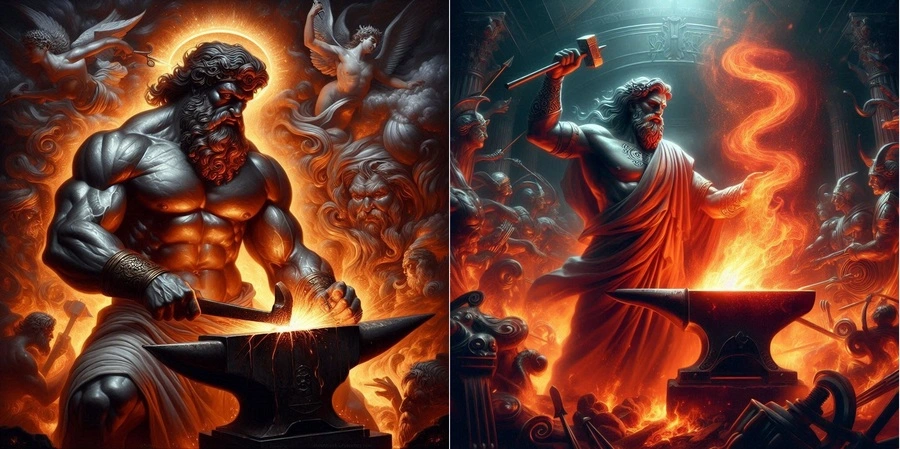
In Greek mythology, Hephaestus was the god of fire, metalworking, and blacksmiths. He was the son of Zeus and Hera, and was believed to have been born weak and deformed. Because of his physical appearance, his mother Hera cast him out of Olympus, causing him to fall to the earth and become crippled.
This early incident not only underscores the harsh realities of divine existence but also sets the stage for Hephaestus’s life marked by resilience and ingenuity. Despite his physical limitations, often depicted as lame or having a deformity, Hephaestus rose to prominence through his unparalleled skills in metallurgy and craftsmanship.
Residing in his grand forges beneath volcanoes, Hephaestus’s workshop was a marvel of ancient imagination, filled with automatons and intricate machinery. Here, he crafted some of the most iconic items in Greek mythology. His creations included the armor of Achilles, the shield of Heracles, and the divine palaces of Mount Olympus.
These masterpieces were not merely weapons or dwellings but were imbued with magical properties, reflecting the god’s profound understanding of materials and their potentials. His work epitomizes the fusion of art and functionality, where beauty and utility coexist harmoniously.
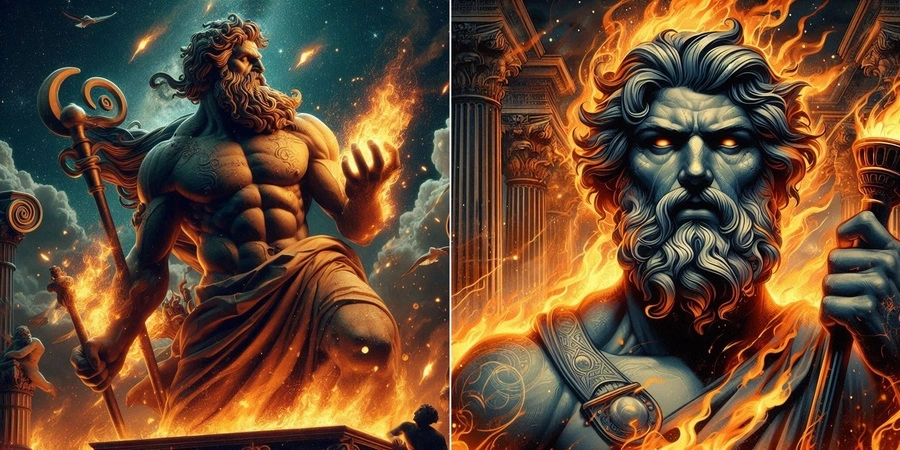
The Story of Hephaestus
Hephaestus was known for his exceptional skills as a blacksmith and metalworker, and he was responsible for creating many of the most famous and powerful objects in Greek mythology. He crafted the thunderbolts wielded by Zeus, the trident of Poseidon, and the armor of Athena, among other notable items.
Despite his talents, Hephaestus was often viewed as an outsider among the gods. His deformities and physical weakness made him an object of ridicule and scorn, and he was not initially welcomed into the company of the Olympian gods. As a result, he spent much of his time working in his forge, creating new tools and weapons for the other gods. Hephaestus was one of the twelve Olympian gods.
Hephaestus’ Family
Despite his difficult relationship with his parents, Hephaestus was married to the beautiful Aphrodite, the goddess of love and beauty. Their marriage was rocky, with Aphrodite having many affairs with other gods and mortals. Despite this, Hephaestus remained a devoted husband, and was often portrayed as the jilted lover in many of the stories involving Aphrodite.
Hephaestus was also believed to have had several children in Greek mythology, including Erichthonius, the mortal king of Athens, and the giant Palaimonius. He was also believed to have fathered the cyclops Polyphemus, who appears in Homer’s epic poem The Odyssey.
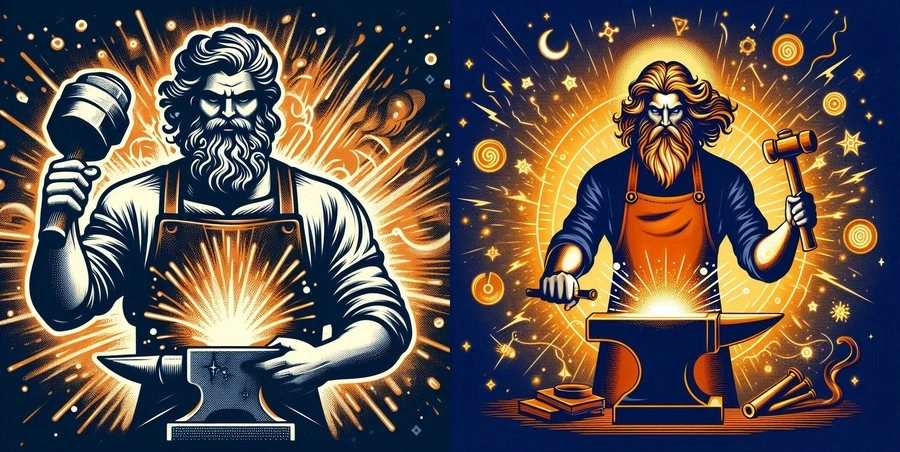
Myths and Facts about Hephaestus
Mythologically, Hephaestus also plays a pivotal role in several key narratives. One notable myth involves his role in the creation of Pandora, the first woman, whose box unleashed evils upon humanity. Commissioned by Zeus, Hephaestus molded Pandora from clay, bestowing her with beauty and charm. This story underscores the duality of his creations, capable of both immense beauty and unforeseen consequences.
Another significant myth is Hephaestus’s involvement in the birth of Athena. According to legend, Zeus, suffering from a severe headache, sought Hephaestus’s help. With a swift blow of his hammer, Hephaestus split Zeus’s head open, allowing the fully grown and armored Athena to emerge. This act of ‘delivery’ not only highlights Hephaestus’s role in divine birth but also cements his importance in the Olympian hierarchy, bridging the realms of physical craftsmanship and divine intervention.
One lesser-known myth features Hephaestus’s attempt to win the affection of Athena. Enamored with her wisdom and beauty, Hephaestus sought to woo the goddess, but Athena, valuing her independence and chastity, rebuffed his advances. In a moment of uncharacteristic impetuosity, Hephaestus tried to embrace her, but Athena eluded him. In the scuffle, his seed fell to the earth, impregnating Gaia (the Earth). From this union, Erichthonius was born, a half-serpent, half-human being who would later become a legendary king of Athens. Athena, taking pity on the child, raised him as her own, and through him, Hephaestus indirectly contributed to the prosperity of Athens. This myth highlights the unintended consequences of Hephaestus’s actions, as well as his lasting impact on Greek civilization.
Another fascinating story involves Hephaestus’s craftsmanship in the creation of Talos, a giant bronze automaton. Talos was designed to protect the island of Crete from invaders. Circling the island’s shores three times a day, Talos was a formidable guardian, whose invulnerability lay in a single vein running from his neck to his ankle, sealed with a bronze nail. This myth illustrates Hephaestus’s ability to imbue his creations with life-like qualities and defensive prowess. Talos’s eventual defeat, by having his vein unplugged, underscores the delicate balance between Hephaestus’s genius and the inherent vulnerability in all creations.
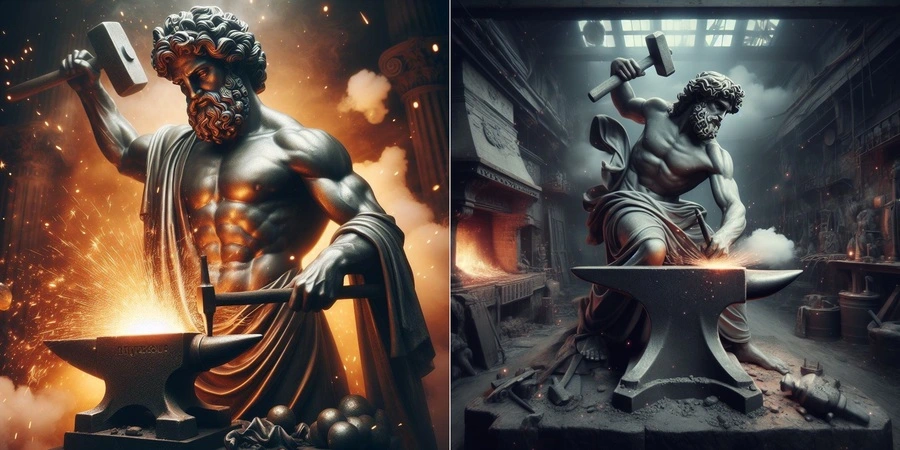
In a more personal aspect of his mythology, Hephaestus’s return to Olympus after being cast out by Hera is a story of ingenuity and reconciliation. According to one version, Hephaestus crafted a magnificent throne and sent it to Hera as a gift. Unbeknownst to her, the throne was a trap, ensnaring her upon sitting. The gods were unable to free her, and it was only Hephaestus who knew how to release the mechanism. He negotiated his return to Olympus in exchange for Hera’s freedom, showcasing his cleverness and his ability to leverage his skills for personal redemption.
Hephaestus’s relationship with his mother, Hera, is further explored in another myth where he avenges her insult by trapping her in a magical golden net. However, despite the bitterness, Hephaestus eventually reconciles with her, reflecting themes of forgiveness and the complex dynamics of familial relationships among the gods.
In another captivating myth, Hephaestus is credited with creating the golden dogs that guarded the palace of King Alcinous of the Phaeacians. These dogs, crafted with exquisite detail and imbued with lifelike qualities, served as both protectors and symbols of divine favor. Their creation demonstrated Hephaestus’s unparalleled ability to blend artistry with functionality, showcasing his role as a divine artisan capable of bestowing his patrons with objects of wonder and utility.
The myth of Hephaestus’s capture of the sun god Helios’s fiery chariot is another tale that highlights his extraordinary skills. Angered by Helios’s constant bragging about his chariot’s unmatched speed and brilliance, Hephaestus devised a plan to humble the sun god. Using his knowledge of metallurgy and mechanics, Hephaestus forged a net of unbreakable chains and laid it across the path of Helios’s chariot. When Helios rode by, he was ensnared, much to the amusement of the other gods. This story not only illustrates Hephaestus’s cunning but also his ability to engineer solutions that even the most powerful gods could not foresee or escape.
The Symbols of Hephaestus
One of the most well-known symbols of Hephaestus is the hammer and anvil. These tools were central to metalworking in ancient Greece, and they represent Hephaestus’s skill as a craftsman and engineer. The hammer and anvil also symbolize the transformative power of fire, which was an essential element in metalworking and which Hephaestus was believed to control.
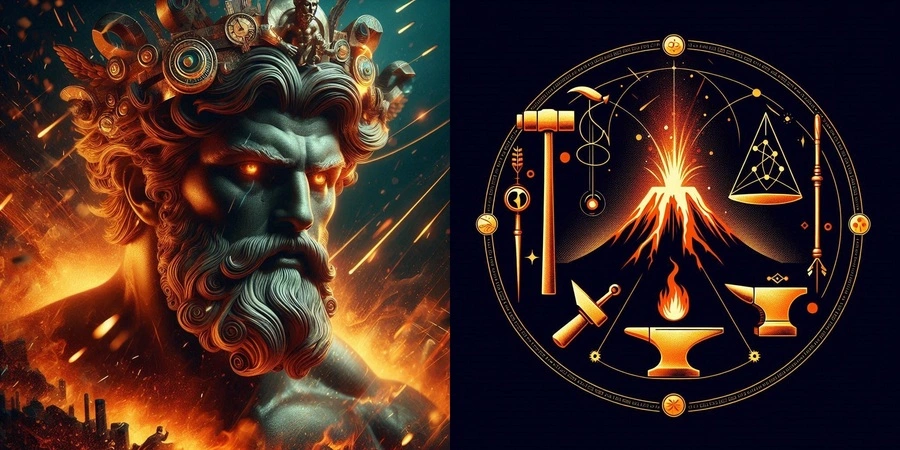
Another important symbol of Hephaestus is the forge. The forge is the place where metal is heated and shaped, and it represents the transformative power of fire and the creative power of Hephaestus. The forge is often depicted in artwork and sculpture as a tribute to the god and his skill as a metalworker.
In addition to the hammer, anvil, and forge, Hephaestus is often depicted wearing a conical hat or carrying a staff. These symbols represent his connection to both technology and the natural world. The conical hat is believed to represent the volcano, which was seen as a powerful and transformative force in ancient Greece. The staff, or scepter, is often associated with authority and power, reflecting Hephaestus’s role as a powerful and influential god.
Frequently Asked Questions
Why Did Aphrodite Marry Hephaestus?
Aphrodite didn’t exactly marry Hephaestus out of love. According to Greek myths, there are two main reasons why they ended up together:
- To avoid chaos: The most popular story says Zeus, the king of the gods, worried that Aphrodite’s beauty would cause a war among the gods who all desired her. By marrying her to Hephaestus, he took her off the “market” and prevented a fight.
- A bargain: Another version suggests Hephaestus, known for his craftsmanship, made a special throne for Hera (Zeus’s wife). When she sat on it, she got stuck! Hephaestus agreed to release her only if he was allowed to marry Aphrodite.
What Is Hephaestus’ Roman Name?
Hephaestus, the Greek god of fire, metalworking, and craftsmanship, is known by the name Vulcan in Roman mythology. Vulcan retained many of the same attributes as Hephaestus, including his association with fire, volcanoes, and blacksmithing. Just like his Greek counterpart, Vulcan was revered as the divine smith, the master of metallurgy, and the craftsman of the gods. The name Vulcan is also where the term “volcano” originates, highlighting his connection to fire and the destructive yet creative power it represents.
What Are Hephaestus’ Powers?
Hephaestus’ powers revolved around his mastery of creation and fire:
- Craftsmanship: Hephaestus’ most renowned power was his incredible skill as a blacksmith and craftsman. He could work with any material, forge fantastical objects, and even imbue his creations with life.
- Fire Manipulation: As the god of fire, Hephaestus wielded immense control over flames. The heat of his forge allowed him to shape metal and fueled his creative process. It’s also said he could transform himself into fire or withstand incredible heat.
- Engineering ingenuity: Hephaestus wasn’t just limited to brute force. He was known for his ingenious designs and creations, even crafting automatons (self-moving machines) to assist him.
Where Does Hephaestus Live?
Hephaestus had two main residences:
- Mount Olympus: As one of the twelve Olympian gods, Hephaestus had his own palace on Mount Olympus. This palace housed his grand workshop, complete with anvils and powerful bellows, where he crafted magnificent objects for the gods.
- Volcanic forges: Hephaestus was also associated with volcanoes, which were seen as his fiery workshops beneath the earth. Some myths mention specific volcanoes, like Mount Etna in Sicily or the island of Lemnos.